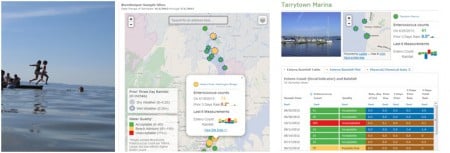Riverkeeper Updates Water Quality Site in Time for July 4th Weekend

View more images on our Flickr site
For Immediate Release
Contact: Tina Posterli, 914-478-4501 x 239 or [email protected]
Shows beach advisories, regulatory action levels and most/least fecal contaminated locations
Ossining, NY – July 3, 2013 – As July 4th weekend approaches, Riverkeeper sheds new light on water quality needs for the region through its updated, interactive, online water quality database. Visitors can now easily evaluate and compare locations on the Hudson River to see which are most suitable for water recreation and which are not. They can determine which sites have fecal contamination triggered by rain and which ones suffer contamination in wet and dry weather. The site now makes it easy for people to see trends, make regional comparisons and identify communities most in need of wastewater investment.
The revised site also incorporates new federal Recreational Water Quality Criteria released by EPA last November, which is currently under review for adoption by NY State. The new EPA criteria recommend a maximum of 110 enterococcus (or Entero, a preferred EPA fecal contamination indicating bacteria), per 100mL in fresh and salt water to achieve an illness rate of no more than 32 illnesses per 1000 swimmers. The old standard was 61 Entero per 100mL in freshwater and 104 Entero per 100mL in saltwater.
Riverkeeper has always used EPA’s federal criterion to score its samples because the federal guidelines are more protective than New York State’s water quality standards for the Hudson, which are based on a weighted average called a geometric mean. In addition to the new 110 threshold for “Unacceptable” recreational water quality, Riverkeeper’s site now also displays a yellow “Beach Advisory” score based on EPA’s new “Beach Action Value” threshold of 60 Entero per 100mL.
“We urge New York State to adopt the new EPA criteria and to use the Beach Action Value for public notification and beach closures on the Hudson River.” said John Lipscomb, Riverkeeper Patrol Boat & Water Quality Program Director. “We see people swimming in the Hudson River from New York Harbor to Troy all summer long. The public is using the river as a 155-mile beach, now the state and counties needs to manage it like one.”
“The public wants to know where and when they can safely recreate in the Hudson. Since we started posting our water quality data online in 2009, tens of thousands of visitors have come to the website seeking that information,” said Tracy Brown, Water Quality Advocate for Riverkeeper. “Our new web tools make it easier for the public to identify patterns of fecal contamination along the Hudson and plan their recreational activities, and their clean water advocacy, accordingly.”
In developing the new site, Riverkeeper worked with the data visualization experts at NiJeL and mWater. “Riverkeeper’s data combined with the maps and graphics we helped to develop should greatly assist with water quality advocacy efforts throughout the region,” said JD Godchaux, Executive Director of NiJeL. “Since all of the software developed for this new site is open-source, Riverkeeper has made a lasting contribution to all concerned citizens who want to measure and understand water quality in their community” said John Feighery, Co-founder and Chief Operating Officer of mWater.
Background
Riverkeeper is the only source for fecal contamination data in the Hudson Valley region. Riverkeeper’s ongoing water quality study, which publishes data online each month (May through October), has led to an increased awareness of this harmful pollution and to important policy changes such as the Sewage Pollution Right to Know Law that went into effect May 2013. Riverkeeper’s Clean Water Action Agenda from the 2012 report “How Is the Water?,” details steps to improve New York State water quality standards, strengthen enforcement of existing water quality protection laws, reduce wet weather overflows and stimulate reinvest in local wastewater infrastructure.
NiJeL’s expertise is in building a deep understanding of our partners’ data, then transforming those data into informative visualizations that help them tell their story. NiJeL works in close collaboration with our partners to make sense of and modernize their data so they can harness actionable information from their many data streams and show the impact they are having on their community.
mWater is an organization that helps people, organizations, and governments gather and share water safety data, specializing in developing countries. Our work with Riverkeeper was an excellent opportunity to share our water quality experience in our own backyard, in the Hudson River Valley.
Riverkeeper’s Water Quality Study is conducted is collaboration with scientists for Lamont-Doherty Earth Observatory at Columbia University and Queens College, City University of New York.

